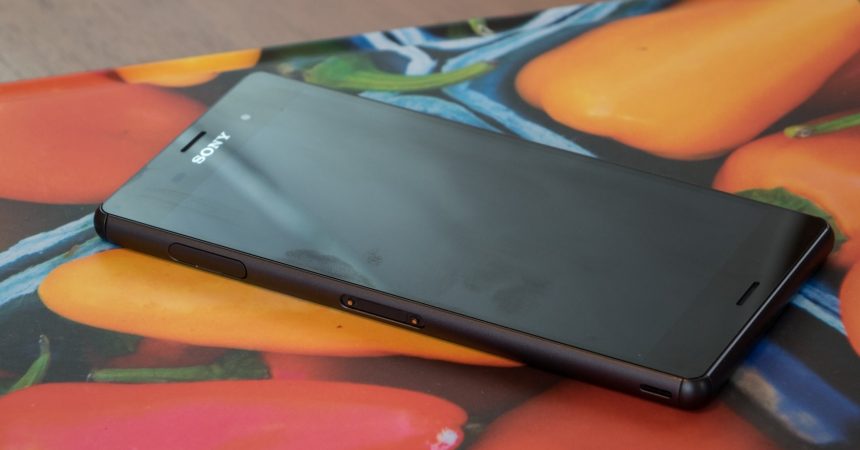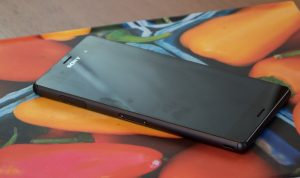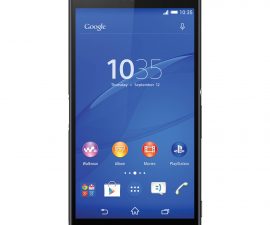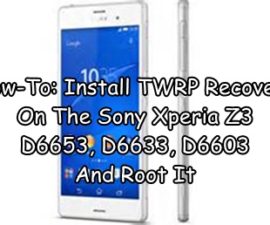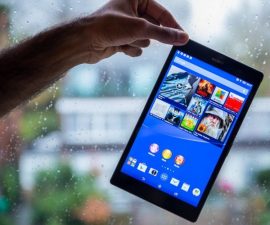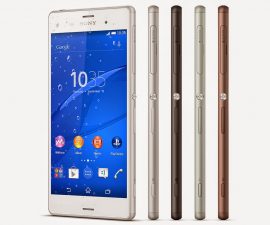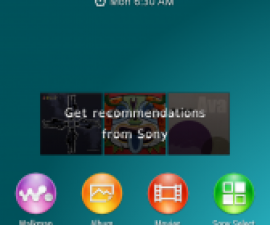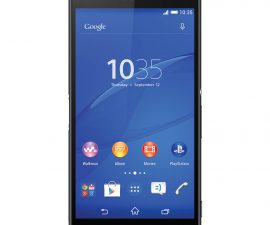The Sony Xperia Z3
Samsung, HTC, and LG have been, in recent years, at the top of their game in terms of smartphones. Sony, on the other hand, had released continuously improving phones (note the Sony S, Sony Z, Sony Z1, and Sony Z2) but nothing was really able to level with the smartphones produced by competitors.
The Sony Xperia Z3 is presumably one of the best in the market and is expected to bring Sony back into the game. Why? It has a great build quality with a 3100mAh battery; a camera coming from a remarkable brand; a simple hardware design language; full immersion capability with an IP68 dustproof and water rating; and the brand itself. Sony may have been challenged in the smartphone market, but it’s still a trusted brand.
There are small improvements from the Sony Z2 such as the slight changes in the chassis (it is now lighter and narrower), the Xperia Z3 is to be used with a nanoSIM, and it has a smaller battery but an increased battery life. Many people argue that this slight improvements are not enough developments; but the increase in LTE band support was noted as a very remarkable addition.
Design and build quality
The good points:
- The Xperia Z3 has a very good build quality – it feels premium and is comfortable to hold. It’s ahead in terms of the build quality, but competitors have also begun to realize the importance of an attractive design and are now stepping up their game as well.
- The device has a glass back that feels solid to touch, though it is a bit slippery. It’s a characteristic that very few Android devices have, such as the HTC One M8 which is all metal.
- It has a dedicated camera button that is very functional. This saves time and allows you to take instant photos or videos. You no longer have to open the lock screen and open the camera app.
- The Xperia Z3 has IP68 dustproof and water ratings, keeping it ahead of most competition for now. For those who prefer a waterproof design that is not made of plastic as in the Galaxy S5, The Xperia Z3 would be a great choice.
- The microUSB port on the Xperia Z3 is better than the one found in the Galaxy S5. although its location on the side is still weird.
The points to improve:
- The circular power button is squishy and difficult to use in the dark, especially because of the phone’s symmetrical build. It’s an advantage that the Z3 has a double-tap to power on feature, which can be reliably used, and therefore omitting the problem with the squishy power button. The power button also looks stylish with its metallic look.
- The volume rocker is too small, difficult to use and press, and located beside the power button. This is possibly because of the Z3’s waterproof feature, but still.
- Still doesn’t match Samsung’s attention to detail, such as that found with the Galaxy Note 4. The Note 4 is more solid, more refined, has better buttons, and it has retained the removable battery.
Display
The good points:
- Sony’s LCD panel is the best in the market, even better than the Super AMOLED panel of Samsung. There’s a slight change in the pixel lighting from the Z2, and this made the panel even better. It appears brighter and consumers les power even at the same level of brightness. Now, that’s efficient.
- Has special adaptive contrast algorithms so that it automatically looks brighter and/or consumers less power while maintaining the brightness.
- The display of the Xperia Z3 is 1080p and offers great sharpness, thus allowing it to consume less power.
- Colors look true and white balance is amazing. The white balance can also be manually adjusted. Compared to Samsung’s Note 4, the Z3’s white balance is way better.
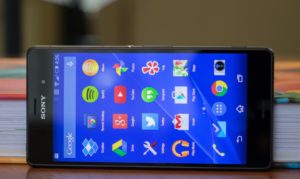
The points to improve:
- Has the traditional white cast that Sony phones have at some angles, but it’s not really that big of a deal. It has been significantly reduced from the ones found in the Z and Z1, so at least we know that Sony is trying to address this issue.
Battery life
The device is rated to have 2 days of battery life, but this is only true: (1) if you are using auto-brightness, and (2) if you are using the default background data queuing feature which prohibits your phone from waking up often when the device’s display is off. The background data queuing feature makes your phone wake up at unspecified intervals so that it can send or receive data. This feature should not be automatically enabled; it’s like Sony is tricking us all just to save battery life. This should be explained by Sony to consumers, or it should not be enabled by default.
Despite this, the Sony Xperia Z3’s 3100mAh battery pack is still usable for moderate to heavy users for one day. It’s actually better than the performance of other devices with the similar size – this performance is better than most competitors like the Samsung Galaxy S5 or LG G3. It’s notable that the device has maintained a light weight in spite of the huge battery. The Z3 is heavier than S5 by only 7 grams, and only 3 grams heavier than LG G3.
On the downside, Sony has not provided a quick charging technology.
Performance and storage
The good points:
- The Z3 has a storage of 32gb, 25gb of which is available for you to use.
- It has a slot for microSD.
- Xperia Z3 is fast and responsive even with heavy usage. Its performance is even more consistent than Samsung’s Note 4. There are no lags even with SwiftKey.
The points to improve:
- WiFi signal is not as strong as competitors. It’s hard to maintain WiFi connectivity. It’s good on 5GHz but the Snapdragon 801 is not helping much here. T-Mobile provides 10mbps to 40mbps of LTE speed.
Audio and call quality
The good points:
- The Z3 uses the same headphone amp as other Snapdragon 800 series devices. The headphone jack’s performance is good.
- Dual front facing speakers are not as loud as expected, but it has good channel separation and midrange punch. These features are not usually available on devices, so it’s a big plus for Sony.
- Call quality is excellent; there’s no problem with the volume and clarity.
Camera
The good points:
- Quality of photos are great provided that you have the right situation.
- Superior Auto mode is enabled by default. This is the best fully-automatic mode that you can use.
- You can manually change the HDR, ISO, metering mode, image stabilization, resolution, and EV. ISO can be set beyond 800 when you’re using full resolution, and the maximum 12,800 can be used only in Superior Auto and the camera thinks that the use of ISO is needed.
- Dedicated camera button saves time and allows you to take immediate photos at any time. It allows the camera app to launch quickly and you can click it on the spot and the camera will take the photo. You won’t ever miss a moment with this camera.
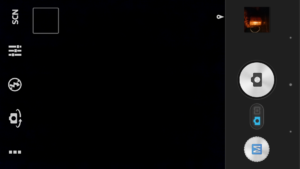
The points to improve:
- The UX of the Xperia Z3 is disappointing.
- Quality of the Exmor RS sensor suffers and is downgraded because of the excessive image processing in dark places. Image processing of Sony’s camera can clean up more image noise than Samsung’s camera, but it is too aggressive.
- White balance is not great, either.
- HDR mode is also not remarkable. Image contrast is not something that you’d expect from this camera. It also can’t be activated in an easy way – you have to use manual mode, then open overflow, then turn on HDR.
- Taking a 15 or 20mp photo in a dark place without using the night processing mode and high ISO is not possible. You have to use the flash.
These issues should be promptly explained to the users. In summary, the Z3’s camera is not what you might call a user-friendly one. It’s disappointing because users have high expectations for Sony’s cameras, mostly because it’s known as one of the best camera manufacturers.
Software
The good points:
- Software navigation buttons are great
- Settings menu is easy to navigate. It’s user friendly, unlike Samsung. It’s easy to find the things you want without giving you a headache. Sony even has a dedicated menu item for your launcher.
- Lots of battery-saving options that can be customized
- It has an extensive theme engine that offers several color schemes and wallpapers. It also supports third party themes that can be bought through the Play Store.
- FM radio app is a great addition to the Xperia Z3. It’s not a common thing in the US, so to find it in the Z3 is just awesome.
- Smart Connect app is a simple task-related app that lets you configure events for devices that you connect on your Z3. For instance, you can configure it in such a way that Google Play Music will automatically launch when you use insert headphones. The phone also has a Playstation app or controller connectivity.
- The Xperia Z3 has a solid performance.
The points to improve:
- Sony Xperia Z3 has a lot of apps that are not really favoured (aka junk). It’s bloated with these useless apps. For instance: background defocus; AR fun; Visual Voicemail; Update Center; Sony Select; Live on YouTube; Google Korean keyboard; Lifelog; What’s New… and a lot other things.
- Notification bar does not look nice. The tab interface is just a waste of space.
The verdict
To sum it up, Sony has definitely done its best to come up with the Xperia Z3, which is one of the best Android smartphone in the market now. The build quality is premium, its battery life is better than competitors, and the performance is stellar. A quick point to consider is Sony’s rather fast release of Z2 and Z3 – with barely a year apart. It’s problematic in the sense that buying an Xperia Z3 now would worry you if the next model would be released in the market immediately after.
The phone’s camera was problematic, but it’s liveable. The pros of the Xperia Z3 outweights the cons, so the $630 for this phone is worth it.
What can you say about the Sony Xperia Z3? Tell us about it!
SC
[embedyt] https://www.youtube.com/watch?v=N0wtA7nRnC0[/embedyt]
